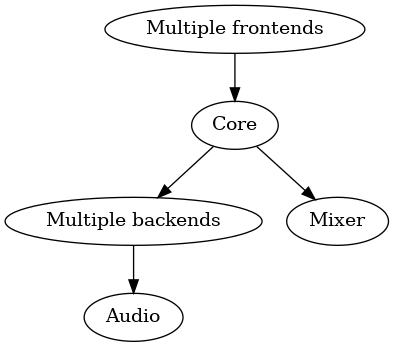Architecture
The overall architecture of Mopidy is organized around multiple frontends and backends. The frontends use the core API. The core actor makes multiple backends work as one. The backends connect to various music sources. The core actor use the mixer actor to control volume, while the backends use the audio actor to play audio.

Frontends
Frontends expose Mopidy to the external world. They can implement servers for protocols like HTTP, MPD and MPRIS, and they can be used to update other services when something happens in Mopidy, like the Last.fm scrobbler frontend does. See Frontend API for more details.

Core
The core is organized as a set of controllers with responsiblity for separate sets of functionality.
The core is the single actor that the frontends send their requests to. For every request from a frontend it calls out to one or more backends which does the real work, and when the backends respond, the core actor is responsible for combining the responses into a single response to the requesting frontend.
The core actor also keeps track of the tracklist, since it doesn’t belong to a specific backend.
See mopidy.core — Core API for more details.

Backends
The backends are organized as a set of providers with responsiblity for separate sets of functionality, similar to the core actor.
Anything specific to i.e. Spotify integration or local storage is contained in the backends. To integrate with new music sources, you just add a new backend. See mopidy.backend — Backend API for more details.

Audio
The audio actor is a thin wrapper around the parts of the GStreamer library we use. If you implement an advanced backend, you may need to implement your own playback provider using the mopidy.audio — Audio API, but most backends can use the default playback provider without any changes.
Mixer
The mixer actor is responsible for volume control and muting. The default mixer use the audio actor to control volume in software. The alternative implementations are typically independent of the audio actor, but instead use some third party Python library or a serial interface to control other forms of volume controls.